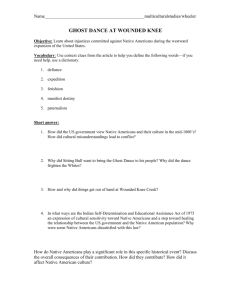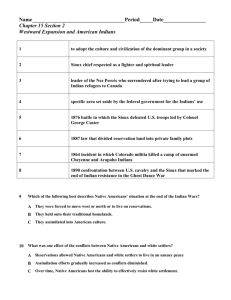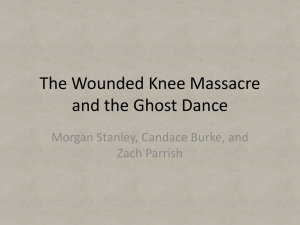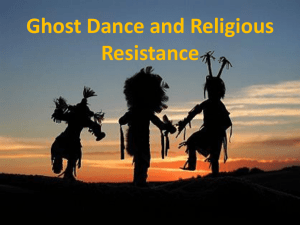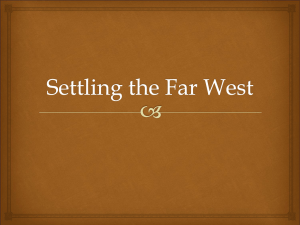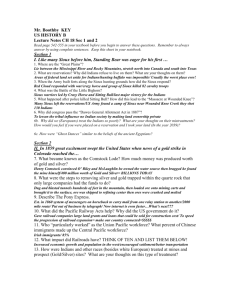The Great West and the Agricultural Revolution
advertisement
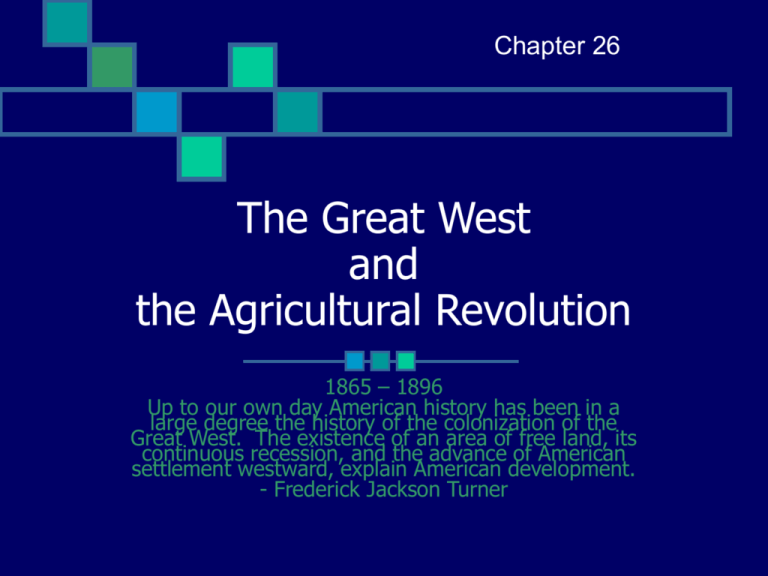
Chapter 26 The Great West and the Agricultural Revolution 1865 – 1896 Up to our own day American history has been in a large degree the history of the colonization of the Great West. The existence of an area of free land, its continuous recession, and the advance of American settlement westward, explain American development. - Frederick Jackson Turner A. The Clash of Cultures on the Plains “Tell your people that since the Great Father promised that we should never be removed we have been moved five times. . . I think you had better put the Indians on wheels and you can run them about wherever you wish.” – Sioux Commission Fort Laramie Treaty marked beginning of reservation system Indians surrendered lands in return for sovereignty White settlers brought disease and hunted buffalo to near extinction Federal Indian agents often corrupt, selling government supplies and substituting motheaten blankets and spoiled meat. 1. Who were the Buffalo Soldiers? At the start of the Civil War, the government withdrew the western army to concentrate on ending the rebellion. 186,000 black soldiers participated in the Civil War Many people feared armed Negro soldiers near their communities. They were also afraid of the labor market being flooded with a new source of labor. Because of their courage, the Native Americans called the black regiments “buffalo” soldiers. 2. Why a Buffalo Soldier? Many African-Americans joined the military for the economic benefits When Congress reorganized the peacetime army, it formed two segregated regiments of black cavalry, the Ninth and Tenth United States Cavalry The troops were sent west to join the army's fight with the Indians. B. Receding Native Population 1. Sand Creek Massacre, Colorado, 1864 Col. Chivington’s militia killed several hundred Cheyenne and Arapaho people, most of whom were still sleeping, believing they were under immunity. The federal government condemned the incident, and attempted to make amends to those who survived by giving them money. “Women were shot praying for mercy, children had their brains dashed out, and braves were tortured, scalped, and unspeakably mutilated.” 1. Cruelty begot cruelty, 1866 Sioux war party trying to stop construction of Bozeman Trail to Montana goldfields Ambushed Capt. Fetterman’s unit 81 soldiers and civilians mutilated Govt. abandoned Bozeman Trail in Treaty of Fort Laramie, 1868 2. Battle of Little Big Horn Also known as “Custer’s Last Stand” Gold discovered in sacred Black Hills Sioux encouraged by Sitting Bull (Hunkpapa Sioux) to defend their land Makes alliance with Crazy Horse (Oglala Sioux) Custer and Seventh Cavalry wiped out trying to suppress uprising 3. Nez Perce and Chief Joseph After government opens Wallowa Valley to mining and settlement, Chief Joseph leads tribe north to escape forceful relocation to reservation. It is cold and we have no blankets. The little children are freezing to death. My people, some of them, have run away to the hills and have no blankets, no food. No one knows where they are--perhaps freezing to death. I want to have time to look for my children and see how many I can find. Maybe I shall find them among the dead. Hear me, my chiefs. I am tired. My heart is sick and sad. From where the sun now stands, I will fight no more forever. 4. Fire-and-Sword Policy Railroad brought unlimited troops, farmers, cattlemen, miners, settlers White people’s diseases Firewater Chief of the Apache, last Native American to surrender to US government C. Bellowing Herds of Bison Native Americans depended on buffalo for: Clothing Food Shelter “We took away their country and their means of support, broke up their mode of living, their habits of life, introduced disease and decay among them, and it was for this and against this they made war. Could anyone expect less? - Gen. Phil Sheridan D. The End of the Trail Helen Hunt Jackson’s book, Century of Dishonor” (1881) exposed the government’s record toward Native Americans 1. The Ghost Dance •Begun in 1888 by Paiute holy man Wovoka. •His vision inspired the followers of the movement, believing the white man would disappear from the Earth after a natural catastrophe and that the Indian dead would return bringing with them the old way of life that would then last forever. •Indians had to practice the customs of the Ghost Dance movement and to renounce alcohol and farming and end mourning, since the resurrection would be coming soon. The Ghost Dance consisted of slow shuffling movements following the course of the sun. It would be performed for four or five days and was accompanied by singing and chanting, but no drumming or other musical instruments. In addition, both men and women participated in the dance. Word spread quickly and the Ghost Dance was accepted by the Utes, Bannocks and Shoshone tribes. 2. Unlike other Dances 3. The Ghost Dance Shirt Eventually, the Plains tribes also adopted the Ghost Dance movement and the peaceful message of hope was spreading and uplifting many Indians. Many tribes added specific customs and rituals to the Dance that reflected their tribes individuality. The Sioux added two specific elements including the use of hypnosis to bring about trances and aid in the communication with the dead, and a ghost shirt. Made of buckskin or cloth, the shirt was said to make the wearer immune to bullets, a weapon of death known initially only to the white man. 4. Sitting Bull A famous Sioux warrior, adopted the Ghost Dance into his way of life. Before dawn on December 15th, 1890, the police burst into Sitting Bull's house, ordered him to his feet, and pushed him toward the door. Outside, Sitting Bull's followers began to gather, vowing to keep them from taking their leader. Sitting Bull hesitated, unsure what to do. One of his supporters shot one of the policemen. Sitting Bull was killed. The soldiers now numbered around 500; the Indians 350, all but 120 of these women and children. Red Cloud, Sitting Bull, Geronimo, Chief Joseph 5. Frightened Indian Agent and the 7th Calvalry His followers fled and joined the band of Kicking Bear. Responding to the pleas of a frightened Indian agent, Washington dispatched 5,000 troops, including the Seventh Cavalry, Custer's old command. Donning their ghost shirts and with their beliefs firm in their hearts, the followers of the Ghost Dance were rounded up at Wounded Knee Creek. 6. The Shirts did not stop the Bullets The soldiers entered the camp demanding all Indian firearms be relinquished. A scuffle ensued and a firearm discharged. At first, the struggle was fought at close quarters, but when the Indians ran to take cover, the Hotchkiss artillery opened up on them, cutting them down. Among those killed were women and children wearing their ghost shirts, which did not stop the bullets of the Indian Agencies or the Military. 7. It Lasted Less Than An Hour Hotchkiss gun used against Indians at Wounded Knee. Corporal Weinart received Medal of Honor for his actions Over 150 Indians were killed and 50 wounded by the end of this brutal, unnecessary violence, which lasted less than an hour. In comparison, army casualties were 25 killed and 39 wounded. Forsyth was later charged with killing the innocents, but exonerated. 8. There were dead people all over . . . . There were dead people all over, mostly women and children, in a ravine near a stream called Chankpe-opi Wakpala, Wounded Knee Creek. The people were frozen, lying there in all kinds of postures, their motion frozen too. The soldiers, who were stacking up bodies like firewood, did not like us passing by. They told us to leave there, double-quick or else. 9. Why? Old Unc said: "We'd better do what they say right now, or we'll lie there too." So we went on toward Pine Ridge, but I had seen. I had seen the dead mother with a dead baby sucking at her breast. The little baby had on a tiny beaded cap with the design of the American flag." 10. “Kill the Indian and Save the Man” Motto, Carlisle Indian School Dawes Act gave family heads 160 acres if they would behave like “good white settlers” US citizenship granted in 1924 Carlisle Indian School separated children from their tribes to teach them “white” values and customs 11. Do You Have What It Takes to Be a Pioneer? Turner’s Thesis Stresses the importance of the continually advancing frontier on American culture He described it as "the meeting point between savagery and civilization" This advancing line "begins with the Indian and the hunter; it goes on with the disintegration of savagery by the entrance of the trader... the pastoral stage in ranch life; the exploitation of the soil by the raising of corn and wheat in sparsely settled farm communities; the denser farm settlement; and finally the manufacturing organization with the city and the factory system." http://www.pbs.org/wnet/frontierhouse/multimedia/interactive.html E. Mining: From Dishpan to Ore Breaker Called “gold-grubbers” or “Forty-niners” Comstock Lode – largest silver deposit ever discovered Encouraged westward movement Financed: Civil War Building railroads Silver will become a campaign issue F. Beef Bonanzas and The Long Drive Movement to cities creates demand for cattle Texas cowboys drove herds over plains to railheads Abilene, Dodge City, Ogallala Transcontinental Railroads brought homesteaders, sheepherders and barbed wire Era of the cowboy began 1. The Era of the Cowboy Long Drive ended after packing houses and refrigerator cars Transcontinental railroad ended long drive Live cattle shipped to stockyards “Beef barons” – Swift & Armour in Chicago G. The Farmers’ Frontier Homestead Act of 1862 gave settlers 160 acres Must remain 5 years and build house Required “dry farming” – shallow cultivation Russian wheat Barbed wire – Joseph Glidden Irrigation and Windmills Sod houses, dirt floors, no running water, no toilets H. The Far West Comes of Age Oklahoma, given to Indians forever, opened to settlement in 1889 Federal troops shot horses of “Boomers” who illegally entered early Settlers known as “Sooners” I. The Fading Frontier 1890 US announced the frontier was closed Farming became an industry – cash crops Farmers compete with locusts, drought, floods, railroad freight rates, the economy 1. Pilgrims of the Plains Mail order began under Aaron Montgomery Ward – first catalogue J. The Farm Becomes a Factory New post Civil War ‘high’ prices persuaded farmers to grow “cash” crops and use profits to buy supplies Mechanization of agriculture makes America the ‘breadbasket’ and the ‘butcher’ of the world K. Deflation Dooms the Debtor Problems Deflated currency due to static money supply Increased production with machines reduced need for farm labor Increased capital costs Just lowered price of farm products L. Unhappy Farmers We will have water near the house for washing and watering stock, but for drinking and cooking I will have to haul a little over 1/4 of a mile till I get time to dig a well. --Uriah to Mattie, April 27, 1873 Fifty miles to water, A hundred miles to wood, To hell with this damned country, I’m going home for good M. The Farmers Take Their Stand or Who were the Grangers? National Grange of the Patrons of Husbandry Organized in 1867 by Oliver Kelley, Minnesota farmer Goal was to enhance the lives of isolated farmers and encourage self-improvement Established cooperative stores and grain elevators Lobbied for regulation of railway rates N. Prelude to Populism The People’s Party Farmers’ Alliance founded in 1870 Created new political party – Populists Platform William Peffer, first Populist US Senator Nationalizing railroads, telephones, telegraph Graduated income tax Free and unlimited coinage of silver Secured several Congressional seats in election of 1892 O. Coxey’s Army and the Pullman Strike Group of unemployed American workers, led by the reformer Jacob Coxey To protest a four-year economic depression, the worst in United States history to that time. Expression "Enough food to feed Coxey's Army" originates from this march. 1. The Wizard of Oz? The purpose was to protest the unemployment caused by the Panic of 1893 and to lobby for the government to create jobs building roads and other public works improvements. 2. First “poor people’s” march on DC The march originated with 100 men in Ohio Groups from around the country joined the march Coxey and other leaders were arrested for walking on the grass of the US Capitol, and the rest of the men scattered. 3. Columbian Exposition Chicago, 1893 The US Postal Service produced its first picture postcards. Cracker Jacks were introduced. Aunt Jemima Syrup was introduced. US Mint offers first commemorative coins: a quarter, half dollar, and dollar. Cream of Wheat was introduced. Shredded Wheat was introduced. Pabst Beer was introduced. Juicy Fruit gum was introduced. Diet carbonated soda was introduced. The hamburger was introduced to the United States. The carnival concept was born. 4. World's Columbian Exhibition Innovations and Legacy The first elevated electric railway ever built. Gray's Teleautograph-A device that electrically reproduced handwriting at a distance. Thomas Edison's kinetograph was a precursor to the movie projector. George Ferris built the first Ferris Wheel. The United States produced its first commemorative stamp set. 5. The White City http://www.randomhouse.com/crown/devilinthewhitecity Largest single common artistic undertaking ever. The world's first Ferris Wheel, invented by George W. Ferris, was on the Midway. The 250-foot high steel structure had 36 cars carrying 60 persons each. 6. Dr. H. H. Holmes "I was born with the devil in me. I could not help the fact that I was a murderer, no more than the poet can help the inspiration to sing." Dr. H. H. Holmes, confession, 1896 7. Young women come to the fair Through fraud and shady business dealings, Holmes became successful and was soon looking for property to expand his empire. The opportunity arrived when the undeveloped land across the street from the pharmacy went on sale. Holmes immediately began to plan his "castle": a strange, ragged building with strange vaults, secret rooms, and a wooden chute that descended from the second floor all the way to the basement. Not even the workers he hired to build it understood the full design of the building. While Burnham and Root busied themselves with the preparation of their enchanting White City on the lake, Holmes was completing the construction of his castle at 63rd and Wallace. The upcoming fair presented itself to Holmes as the perfect opportunity. His dark castle would become a hotel for the fair. 8. Chicago Not a Happy Town Pullman strike of 1894 Organized by Eugene V. Debs with American Railway Union Company cut wages by 1/3, but kept company house rents the same Pres. Cleveland ordered federal troops crush the strike for interfering the transit of US mail P. Golden McKinley and Silver Bryan Election of 1896 The Gold Standard, Bimetallism, or 'Free Silver'? After the Civil War, Greenbacks were recalled until they could be backed 100% with gold. This is known as the ‘gold standard.’ This caused inflation which hurt workers and borrowers The Silver Candle, political cartoon 1. What’s the Deal with the Silver? William Jennings Bryan Of Nebraska Farmers hoped that free silver might cause inflation and end depression 2. Divides the Democrats “ Democrats nominated Bryan on platform of unlimited coinage of silver With gold ratio of 16 to 1 3. “Cross of Gold” speech Bryan’s speech at Democratic convention “We will answer their demands for a gold standard by saying to them: You shall not press down upon the brow of labor this crown of thorns, you shall not crucify mankind upon a cross of gold.” US stopped using silver and sold surplus in 1970 4. Democratic Party Divided “A great exhibition, but rather trying on the one in the middle” Chicago Record, July, 1896 5. Election of 1896 William McKinley of Ohio – Republican Encouraged by Marcus Hanna, who believed business of government was aiding business Democrats divided into Silver Democrats Gold Democrats Prohibition Party also ran candidate Q. Class Conflict: Plowholders Versus Bondholders Disappointment at the Polls New era of American politics Last effort to win White House with farm voters Less voter participation Weakening of party organizations Less importance of issues R. Republican Stand-pattism Enthroned McKinley won High tariff passed to reward industrialists who had contributed to campaign Needed to cover government deficits End of Depression of 1893 New gold discoveries in Klondike kept US on gold standard Ended silver demands 1. Assassination of President McKinley Iit was poor medical technique not bullet which caused McKinley's death. The wound was closed without disinfecting McKinley died September 14, 1901 of gangrene. Czolgosz was electrocuted on October 29 and "someone" then poured sulphuric acid on his face, while Czolgosz lay in his coffin, prior to a hasty burial.
